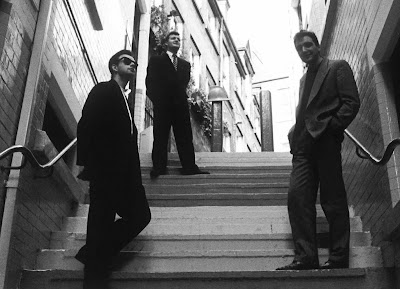I was searching the web this morning and saw a Google Adword for Woolworths.
I did hear that they were back, but click here for proof.
http://www.woolworths.co.uk
By reading over their blog, it seems like they are being sensible and trying to correct the mistakes that took them down in the first place. They talk about defining a range designed for their web shopping format and even seeing if they can make Pick and Mix work on the Web.
If they can take the best of the Woolworths brand values and build on them, they may have a chance of building a new business with the old name.
Its a shame they missed out on all the Easter Egg sales for 2009 as in a business article on radio four yesterday it was said that the reason Tesco and Sainsbury are selling so many cheap Easter Eggs at present, is that they bought them all from Wooolies administrators. I guess that is our gain?
Whilst Woolies was always far from perfect, it will be interesting to see if the new owners can do a 'Skoda' with it and turn it from 70's joke into a sharp responsive retailer that would have allowed them to survive in the first place.
Thursday 26 February 2009
Monday 23 February 2009
Discounting kills brands – you simply HAVE to add value
As long ago as 1994 when we were working for a world class Racing Drivers School at Donington Park in UK. They came to us with a problem of a winter course that was almost impossible to sell out and they wanted us to produce a flyer for them to help sell it at a discounted price of £1800 for the five day programme rather than the full price of £2500.
We talked them into an idea of offering an additional 15 hours of one on one instruction that had a perceived value of £1200 but an actual cost to the school of less than £200. Guess what? The programme became the most popular and sold out almost immediately.
We already suspected the power behind adding value but this was our first definitive proof.
Well this has now been confirmed by none other than Martin Lindstrom who is one of the most forward thinking of any current brand strategist.
His supposition is that discounting a brand will take SEVEN years to recover from as this is how long the cycle takes for it to be built back up to a brand that is valued.
If you look at the huge brands now literally dumping their products through the likes of TK Maxx in a desperate search for volume, I would have to ask whether they will even survive long enough to get to the end of that seven year cycle.
If you can buy a Calvin Klein jumper in TK Maxx for £25 in their traditional grey colour, why would you want to pay £100 and more, just to have it in a better bag – particularly when some would now be embarrassed to be seen with such a conspicuous sign of excess that a Calvin Klein bag represents.
So for us, the key for the long term success of any brand is to find ways of adding value to your brand.
Tony Parsons - who we have previously described as an unwitting brand guru in many presentations delivered over the years - writing in his book Man and Wife, was trying to establish why his parents had managed to stay married for so long. His Mum’s answer was simple
By learning to fall in love over and over again.
The same can be said for managing any great brand, because the best brands have an emotive element that people love over and above all reason.
An emotional brand gives their customers reasons to fall in love with them over and over again. They act as though they are in a real relationship with them and if they do it well and keep doing it well, they may be lucky enough stay in that relationship with them forever.
The secret seems to be to reward them, surprise them, say thank you, respect them and treat them as intelligent individuals. Just like in a conventional relationship, if you make more of an effort, you are far more likely to succeed.
So. Don’t discount. Delight instead.
We talked them into an idea of offering an additional 15 hours of one on one instruction that had a perceived value of £1200 but an actual cost to the school of less than £200. Guess what? The programme became the most popular and sold out almost immediately.
We already suspected the power behind adding value but this was our first definitive proof.
Well this has now been confirmed by none other than Martin Lindstrom who is one of the most forward thinking of any current brand strategist.
His supposition is that discounting a brand will take SEVEN years to recover from as this is how long the cycle takes for it to be built back up to a brand that is valued.
If you look at the huge brands now literally dumping their products through the likes of TK Maxx in a desperate search for volume, I would have to ask whether they will even survive long enough to get to the end of that seven year cycle.
If you can buy a Calvin Klein jumper in TK Maxx for £25 in their traditional grey colour, why would you want to pay £100 and more, just to have it in a better bag – particularly when some would now be embarrassed to be seen with such a conspicuous sign of excess that a Calvin Klein bag represents.
So for us, the key for the long term success of any brand is to find ways of adding value to your brand.
Tony Parsons - who we have previously described as an unwitting brand guru in many presentations delivered over the years - writing in his book Man and Wife, was trying to establish why his parents had managed to stay married for so long. His Mum’s answer was simple
By learning to fall in love over and over again.
The same can be said for managing any great brand, because the best brands have an emotive element that people love over and above all reason.
An emotional brand gives their customers reasons to fall in love with them over and over again. They act as though they are in a real relationship with them and if they do it well and keep doing it well, they may be lucky enough stay in that relationship with them forever.
The secret seems to be to reward them, surprise them, say thank you, respect them and treat them as intelligent individuals. Just like in a conventional relationship, if you make more of an effort, you are far more likely to succeed.
So. Don’t discount. Delight instead.
This press release is online at Pressbox, which you can see by clicking here
Labels:
brand values,
branding,
Calvin Klein,
Martin Lindstrom,
TK Maxx,
Tony Parsons
Tuesday 3 February 2009
Back to the future
Back in 1995, we wrote a proposal for Machine Mart, who we then went on to work with successfully for many years, helping them almost double the size of their business.
A few things remain unchanged in this document from all those years ago.
1. Machine Mart's logo - Which shows that changing a logo is not always the answer to running a business or even making a mark when you take over one.
2. Purple Circle's business values. Even in 1995, they read as follows:
Firstly we only take on projects that play to our strengths - namely those that involve creative thought and project management;
Secondly when we submit a quotation we will stick to it. We will not keep adding extras for 'author's alterations' at the design stage, unless you completely change the brief;
And finally, design comes last. When we are given a brief we stop and think. We don't rush headlong into trying to sell a visual we think you want to buy. We only supply relevant creativity - relevant to your brief. We are not in the business of designing for aesthetic criteria alone and good design is drawn from clarity of thought.
The amazing thing for me is that even after all this time, those are still three of our core values in trading with any client - old or new.
Getting your organisational values right can be brilliant for any business. They give you a clear direction to influence any business decision.
It also said rather proudly that Purple Circle had been established for over four years. That seems like absolutely ages ago now as its just about to be 18 years.
Getting your business values right and then sticking to them for year after year after year ensures that any customer, old or new also knows what they can expect from you or your brand and ensures you know how to recruit potential staff who understand what your business is really all about.
And for your amusement, this is what the three of us looked like back then!

A few things remain unchanged in this document from all those years ago.
1. Machine Mart's logo - Which shows that changing a logo is not always the answer to running a business or even making a mark when you take over one.
2. Purple Circle's business values. Even in 1995, they read as follows:
Firstly we only take on projects that play to our strengths - namely those that involve creative thought and project management;
Secondly when we submit a quotation we will stick to it. We will not keep adding extras for 'author's alterations' at the design stage, unless you completely change the brief;
And finally, design comes last. When we are given a brief we stop and think. We don't rush headlong into trying to sell a visual we think you want to buy. We only supply relevant creativity - relevant to your brief. We are not in the business of designing for aesthetic criteria alone and good design is drawn from clarity of thought.
The amazing thing for me is that even after all this time, those are still three of our core values in trading with any client - old or new.
Getting your organisational values right can be brilliant for any business. They give you a clear direction to influence any business decision.
It also said rather proudly that Purple Circle had been established for over four years. That seems like absolutely ages ago now as its just about to be 18 years.
Getting your business values right and then sticking to them for year after year after year ensures that any customer, old or new also knows what they can expect from you or your brand and ensures you know how to recruit potential staff who understand what your business is really all about.
And for your amusement, this is what the three of us looked like back then!

Labels:
brand values,
branding,
Machine Mart,
Purple Circle
Subscribe to:
Posts (Atom)
